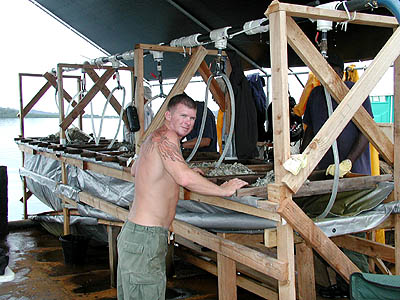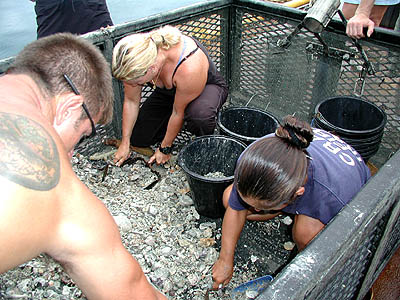| P-MAN
VII SUMMARY of 19-24 May 05: An Event To Remember After finishing up a busy Thursday at work, I hopped a flight to Honolulu, beginning my thirteenth trip to Palau. Just the day before, two important things had happened:
After a layover at Honolulu Airport Hotel I met Clem, all tanned from surfing off Hawaii's north shore. We boarded CO 1 for Guam (now a commuter flight for some of us) and had an uneventful flight. We headed for Palau through Yap (famous for their huge stone money dowries), where half the plane (mine of course) was unloaded for a security check, during which I got eaten alive by mosquitoes. We landed at Palau International Airport at 9 p.m. (local) and Clem whipped out his camera, started filming me during baggage claim and was relentless and single-minded from then until we landed at Hickam AFB two days later. We were expecting to meet our Master Guide, Joe Maldangesang, at the airport but we found out that Joe had been called to a funeral of a cousin. We took the West Plaza bus to the hotel. After checking in, we walked over to Sam's (dive shop and favorite watering hole) which was closed (!). Undaunted, we then walked to Kramer's (another favorite) which was still serving drinks. Jane, behind the bar, made us (and everyone else) at home and Rene (the Austrian ex-pat owner and fisherman) served up some tremendous sashimi for Clem and me in honor of our arrival. We got caught up on island gossip and got relaxed and at some point got back to the hotel. After sleeping in, e-mail catch-up and a late breakfast (now Sunday in Palau), we spent the day making the rounds to let people know about our quick visit. We walked over to Neco Marine (our dive and boat shop) - Joe was still at the funeral (till Monday) and Bert Yates (one of our favorite dive masters and underwater photographer) was out diving. We then walked to Sam's and saw General Manager and good friend, Dermot Keane. Not much new at Sam's:
It is getting to be Palau's quiet season for tourism. It also was very hot and humid, noticeably more than February and March, when we are usually there – which reaffirms that the time frame we use for BentProp search missions is the right one. Dermot graciously gave us a drive into town (on Koror, a different island) and dropped us at the Palasia Hotel, where the JPAC team was staying. We contacted Captain Sean “Zeke” Zukowsky, USMC (JPAC Recovery Team-2 (RT-2) Officer-in-Charge), whom we met in the lobby along with Dr. Eric Emery, the RT-2 anthropologist (a really neat guy). Clem filmed Captain Zukowsky and me going over the ceremony details (one of the items on Clem's shot list). We learned from Dr. Emery (public knowledge) that they had recovered (so far) what appears to be one set of remains, of possible human origin, from this 13th AAF B-24 lying under 70 feet of water near Koror. The description of what the 16 Navy divers and 4 JPAC team members accomplished, under Dr. Emery's direction and Captain Zukowsky's leadership, was nothing less than phenomenal. [NOTE: JPAC regulations do not permit release of any details or names concerning human remains and related findings, so the description below does not include any information about specific findings.] RT-2 focused their recovery efforts on the tail section of the B-24, lying on the east side of a coral head (see www.bentprop.org, P-MAN VI report). Apparently and not surprisingly, the (mangrove) silt that daily clouds the waters of the crash site settles in layers. The Navy divers were able, using a surface pump, to suction gently down through the silt, layer by layer, both inside and outside the fuselage. The materials suctioned were then filtered and carefully screened on board the barge, which was anchored above the crash site. However, as they suctioned around the fuselage, it became progressively more unstable and potentially less safe for divers. At that point the team's Master Diver, David Gove, later told me he made the safety call and halted further work for RT-2. Since Dr. Emery believes, as we do, that more may still be found in the tail section, they suspended work, recommending that JPAC return next year, after coming up with a plan for stabilizing the tail. RT-2 did not work on the nose and ball turret area on the west side of the coral head, but they told me they also feel that area needs to be explored in detail as well. The divers spent 20,000 minutes underwater (which for a Navy salvage dive team job is a big job) with no medical issues. They had excellent weather in April, but during May it rained constantly, with many delays (e.g., electrical shorts, water in fuel lines – which is not good when hard helmet diving). They dismantled the barge the day before Clem and I arrived.
Captain
Zukowsky told us that there would be a single transfer container in the ceremony
with the one set of remains. We completed our interview and they both invited
us to RT-2's celebration dinner at Kramer's at 1800 that evening. |
|
Page last modified 27 August 2005 | ||





